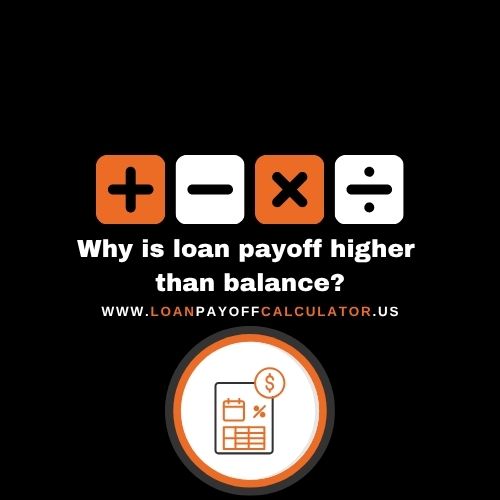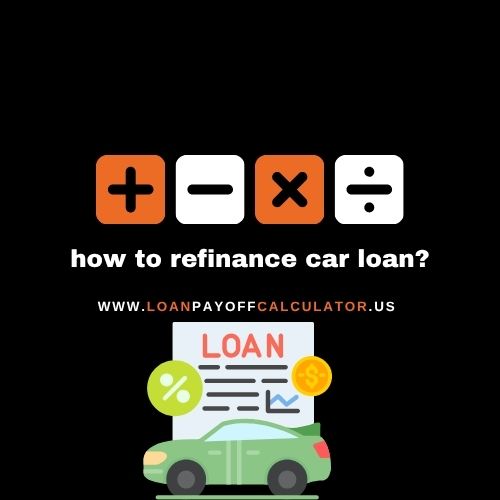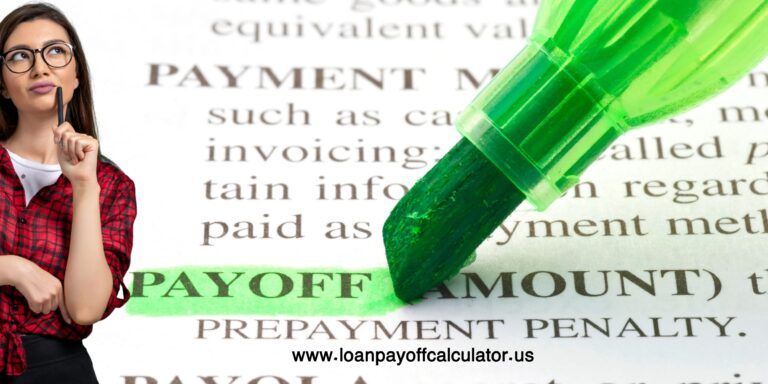Why Is Loan Payoff Higher Than Balance? – Hidden Costs Explained
Short answer: your loan payoff is often higher than the displayed remaining balance because it includes
accrued daily interest up to the exact payoff date—plus any fees (late, processing, or prepayment).
Example: your online balance shows $10,000. When you request a payoff letter, the lender quotes $10,300.
That extra $300 is typically interest that accrued since your last statement + any applicable fees.
If you’ve ever wondered why your loan payoff is higher than the balance, here’s the full explanation and how to avoid surprises.
- Ask for an official payoff quote with a good-through date (often 10–15 days). Amounts change daily with interest.
- Pay on or before the quote’s date to avoid extra per-diem interest.
- Scan for fees (late, processing, or prepayment) and ask if any can be waived.
Balance vs. Payoff: What’s the Difference?
Many borrowers confuse their loan balance with the actual payoff amount. Here’s the key difference:
- Balance: The remaining principal plus any posted interest, but not including interest that accrues daily or extra fees.
- Payoff: The true amount you need to close the loan. It includes your balance plus accrued interest up to the payoff date and any additional charges (e.g., late fees, processing fees, or prepayment penalties).
Example: Your account shows a balance of $5,000. When you request a payoff letter, the lender quotes $5,120.
Breakdown → $5,000 (balance) + $20 (accrued interest) + $100 (fees).
| Balance | Accrued Interest | Fees | Total Payoff |
|---|---|---|---|
| $5,000 | $20 | $100 | $5,120 |
Reasons Your Loan Payoff Is Higher Than the Balance
Seeing your payoff amount come in higher than your online balance can feel confusing—but it’s usually because of these common factors:
- Accrued daily interest: Interest continues to build on your loan every single day until the payoff date. Even a few days can add noticeable dollars.
- Prepayment penalties: Some loans (especially older auto or personal loans) include an early payoff fee that gets added to your total.
- Late fees or unpaid charges: Any outstanding late fees, past-due charges, or small unpaid balances are rolled into the payoff quote automatically.
- Processing or statement fees: A lender may add administrative costs for preparing your official payoff statement.
Together, these items explain why your payoff is often a few hundred dollars—or more—above the balance you see online.
Example Calculation: Why Payoff > Balance
Here’s a simple example that shows how your payoff amount can end up higher than the balance shown online:
| Balance | Daily Interest | Fees | Total Payoff |
|---|---|---|---|
| $10,000 | $3/day × 10 days | $50 | $10,080 |
That’s why the payoff can be higher than your “online balance.”
How to Check Your Exact Payoff
To avoid surprises, always confirm your exact payoff amount before sending a final payment. Here’s how:
- Request a payoff letter: Contact your bank or lender and ask for an official payoff statement. This document lists the full amount needed to close your loan.
- Check the expiration date: Payoff letters are usually valid for 10–15 days. Because interest accrues daily, the quoted payoff is only accurate through the date listed.
- Ask about prepayment penalties: Before sending funds, confirm whether your loan includes any early payoff fees so you know the true total.
Getting a payoff letter is the safest way to ensure you don’t underpay—or overpay—when closing out your loan.
Tips to Save on Your Loan Payoff
A few smart moves can reduce how much extra you pay when closing your loan. Consider these strategies:
- Pay right before your interest date: Making your final payment just before the next interest posting can minimize daily accruals.
- Double-check late fees: If you already paid late charges, make sure they aren’t still showing on your payoff statement.
- Negotiate small fees: Some lenders will waive administrative or processing fees if you ask—it never hurts to try.
Even small savings—like avoiding a week of extra interest or a $50 fee—can add up when you’re paying off a loan in full.
Other Factors That Can Raise Your Payoff Amount
Beyond daily interest and standard fees, several details in the U.S. lending system can make your loan payoff amount higher than your balance:
- Per-diem interest: Lenders calculate interest daily. Even a few days’ difference between your request and payment date can raise the payoff by $10, $50, or more depending on loan size.
- Mortgage rules: For mortgages, lenders often calculate interest through the end of the month—even if you pay mid-month—so the payoff may look inflated.
- Timing of payment: If your payment falls before the billing cycle closes, your online balance may not yet include all accrued charges.
- Administrative or statement fees: Some lenders tack on small charges ($25–$100) for processing your payoff request.
- Prepayment penalties: While less common today, certain auto loans and older mortgages still impose a penalty for early payoff.
- Communication gap: The balance you see online is not the final figure. Only the official payoff quote reflects the exact amount owed to close the loan.
Knowing these factors upfront helps you plan your payment timing, avoid surprises, and ensure your loan closes smoothly.
Loan Payoff FAQs
1. Why is my payoff amount more than the balance?
Because it includes daily interest that has accrued since your last payment and may also add fees or charges.
2. Do all loans have a higher payoff than balance?
Most installment loans will, since interest accrues daily. But the difference can be small if you’re close to your due date and no fees apply.
3. How can I avoid prepayment penalties?
Check your loan agreement before refinancing or paying off early. Many modern lenders don’t charge them, but some older contracts still include penalties.
4. How long is a payoff quote valid?
Payoff letters are typically valid for 10–15 days. After that, you’ll need an updated quote because interest continues to accrue.
Try Our Exclusive Loan Tools — Built for Smarter Payoff
These free, premium-grade calculators were designed for real borrowers like you.
Plan faster student loan payoff, reduce interest, and compare repayment strategies with ease.
Loan Payoff Calculator →
Loan Interest Calculator
Loan Comparison Calculator
Loan Refinance Calculator
No guesswork. No hidden fees. Just the smartest way to manage any loan payoff.
Conclusion: Why Payoff Is Higher Than Balance
In short, your loan payoff is usually higher than your balance because of daily interest accrual, fees, and timing rules.
Understanding this difference helps you plan the right payoff date, avoid unnecessary charges, and close out your loan with confidence.
✅ Quick tips to finish strong:
- Pay before cycle close: Timing your payoff right before your billing cycle ends can minimize added daily interest.
- Ask for fee waivers: Some lenders may waive small administrative or statement fees if you request it.
- Keep payoff proof: Always save your payoff letter and payment confirmation in case of future disputes.
For official guidance on loan payoff and prepayment, visit the
CFPB – Loan Payoff & Prepayment Guide
.







